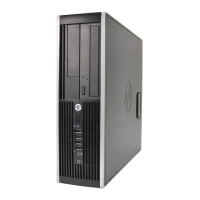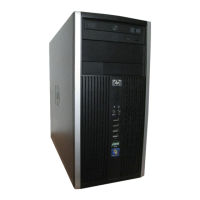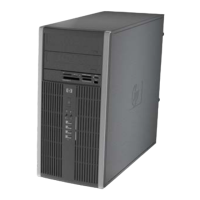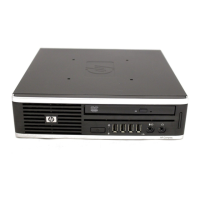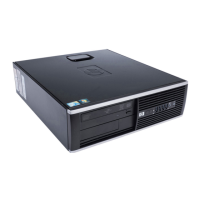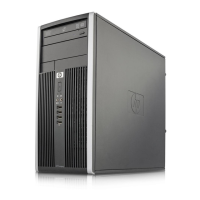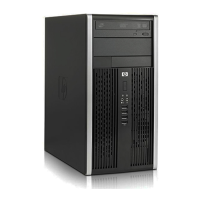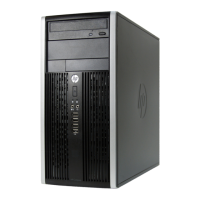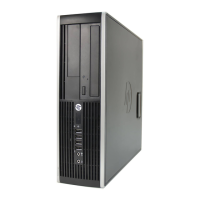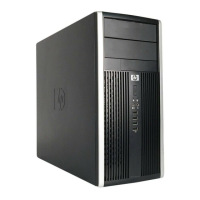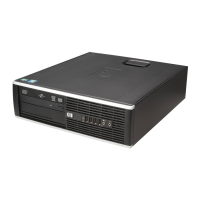




Do you have a question about the HP Compaq 6005 Pro and is the answer not in the manual?
| Processor cache | 2 MB |
|---|---|
| Processor cores | 2 |
| Processor model | B26 |
| Processor family | AMD Athlon II X2 |
| Processor frequency | 3.2 GHz |
| Processor cache type | L2 |
| Processor manufacturer | AMD |
| Number of processors installed | 1 |
| Operating system installed | Windows 7 Professional |
| Compatible operating systems | FreeDOS |
| Operating system architecture | 32-bit |
| HDD speed | 7200 RPM |
| HDD interface | SATA |
| Optical drive type | DVD Super Multi |
| Card reader integrated | Yes |
| Total storage capacity | 320 GB |
| Audio system | HD |
| Product type | PC |
| Motherboard chipset | AMD 785G |
| Memory slots | 4x DIMM |
| Internal memory | 2 GB |
| Memory clock speed | 1333 MHz |
| Internal memory type | DDR3-SDRAM |
| Maximum internal memory | - GB |
| Memory layout (slots x size) | 1 x 2 GB |
| Networking features | Gigabit Ethernet |
| Floppy drive installed | No |
| Compliance industry standards | IEEE 802.3, IEEE 802.3u, IEEE 802.3ab |
| Discrete graphics card model | AMD Radeon HD 4200 |
| Display diagonal | 24 \ |
| Display brightness | 300 cd/m² |
| Display resolution | 1920 x 1200 pixels |
| Native aspect ratio | 16:10 |
| Viewing angle, horizontal | 160 ° |
| USB 2.0 ports quantity | 6 |
| Parallel ports quantity | - |
| Firewire (IEEE 1394) ports | 0 |
| Cabling technology | 10/100/1000Base-T(X) |
| Ethernet LAN data rates | 10, 100, 1000 Mbit/s |
| Chassis type | Micro Tower |
| Product color | Black |
| Country of origin | China |
| Power supply input voltage | 110 - 240 V |
| Power supply input frequency | 50 - 60 Hz |
| Depth | 430 mm |
|---|---|
| Width | 176 mm |
| Height | 377 mm |
| Weight | 9300 g |
Describes the components located on the front of the HP Compaq 6005 Pro Business PC.
Details the various ports and connectors found on the rear of the HP Compaq 6005 Pro Business PC.
Provides step-by-step instructions for installing the operating system on the computer.
Guides users on how to download and install necessary updates for the Windows operating system.
Explains the process of installing or updating device drivers for hardware components.
Offers guidance on adjusting display settings like resolution, refresh rate, and color.
Explains how to access and utilize disk image files for software installation and diagnostics.
Outlines the various functions and capabilities of the F10 Computer Setup utility for system configuration.
Provides a step-by-step guide on how to navigate and use the F10 Computer Setup utility.
Covers options within the 'File' section of Computer Setup, including system information and ROM flashing.
Details storage-related settings within Computer Setup, such as drive emulation and translation modes.
Explains security features available in Computer Setup, including passwords and device security options.
Describes power management settings within Computer Setup, covering OS and hardware power options.
Presents advanced configuration options within Computer Setup, including POST settings and device management.
Guides users on how to save and restore system configuration settings using Computer Setup utilities.
Provides characteristics and specifications for SATA hard drives supported by the computer.
Discusses guidelines for using and handling SATA data cables to prevent damage.
Explains the Self-Monitoring, Analysis, and Reporting Technology (SMART) for ATA drives.
Details the limits and calculations for drive and partition capacities based on file systems and OS.
Identifies different chassis types, specifically the Ultra-Slim Desktop (USDT).
Provides critical information on preventing damage to electronic components from static electricity.
Outlines essential precautions for handling sensitive electronic parts and assemblies.
Details the equipment and methods required for personal grounding to prevent ESD.
Provides precautions for establishing a safe, static-free work environment.
Lists recommended materials and equipment for preventing static electricity.
Offers guidelines for optimal computer operation to prevent overheating and prolong life.
Covers general maintenance and care procedures for the computer.
Lists essential safety precautions to follow before cleaning any computer components.
Provides instructions on how to clean the exterior casing of the computer.
Offers guidance on cleaning the computer keyboard, including under the keys.
Details how to safely clean the computer monitor screen and body.
Explains the procedure for cleaning the computer mouse.
Lists important considerations for disassembly and assembly of computer components.
Discusses the variable-speed fan within the power supply unit.
Lists the necessary tools and software for servicing the computer.
Provides information on screw types and the importance of keeping them organized during disassembly.
Offers guidance on handling and routing internal cables and connectors to prevent damage.
Details proper handling procedures for hard drives, including static discharge precautions.
Provides information about the computer's lithium coin cell battery and its handling precautions.
Outlines the essential steps and safety precautions to take before disassembling the computer.
Indicates where to find the serial number and product ID for customer service.
Explains how to use security locks to protect the computer from theft.
Provides instructions for installing various types of security locks.
Details the installation of a specific type of security cable lock on the computer.
Illustrates how to use a padlock for securing the computer.
Describes the procedure for installing and using the HP Business PC Security Lock.
Explains how to secure the front bezel using a special security screw.
Details how to install and remove the optional rear port cover.
Provides instructions on how to remove and replace the computer's access panel.
Describes the process for removing and installing the front bezel of the computer.
Explains how to remove a bezel blank to install a drive.
Guides the user through the process of installing additional RAM modules (SODIMMs).
Details the specifications and requirements for SODIMM memory modules.
Specifies the compatibility and requirements for DDR3-SDRAM SODIMMs.
Explains how to identify and use the SODIMM sockets on the system board.
Provides step-by-step instructions for installing SODIMM memory modules.
Offers best practices for managing internal cables within the computer.
Details the procedure for removing and replacing the computer's optical drive.
Provides step-by-step instructions for taking out the current optical drive.
Explains how to prepare a new optical drive for installation by attaching its release latch.
Guides the user through the process of installing a new optical drive into the computer bay.
Covers the removal and installation of the computer's internal hard drive.
Details the removal and installation procedure for the hard drive cage.
Explains how to remove and replace the front cooling fan.
Provides instructions for removing and installing the computer's card reader.
Describes how to remove and replace the computer's hood sensor.
Details the procedure for removing and replacing the internal computer speaker.
Explains how to remove and reinstall the CPU heat sink.
Provides instructions for removing and replacing the TV tuner module.
Guides the user through the safe removal and installation of the computer's processor.
Details the careful procedure for removing and replacing the main system board.
Explains how to remove and replace the rear cooling fan.
Covers the removal, replacement, and handling precautions for the computer's CMOS battery.
Instructions for reconfiguring the computer from a desktop to a tower orientation.
Information regarding the external power supply unit used with the computer.
Details pin assignments for keyboard connectors and signals.
Details pin assignments for mouse connectors and signals.
Explains pin assignments for the Ethernet RJ-45 network connector.
Details pin assignments and signals for USB connectors.
Provides pin assignments for microphone connectors.
Details pin assignments for headphone connectors.
Explains pin assignments for the line-in audio connector.
Details pin assignments for the line-out audio connector.
Provides pin assignments and signal details for monitor connectors.
Details pin assignments and signal types for the DisplayPort connector.
Explains pin assignments for SATA data and power connectors.
Lists general requirements for power cord sets used with the computer.
Specifies power cord requirements for use in Japan.
Outlines country-specific power cord requirements and approvals.
Guides on using Windows 7 Backup and Restore for data protection and recovery.
Explains strategies and methods for backing up computer data regularly.
Details how to recover files and the system using various recovery tools.
Instructions on using Windows built-in recovery tools for system restoration.
Explains how to use the F11 key for system recovery and restoring the original image.
Provides steps for recovery using a separate Windows 7 installation DVD.
Guides on using Windows Vista Backup and Restore Center for data protection.
Details system recovery procedures using Windows Vista tools.
Explains how to use the F11 key for system recovery in Windows Vista.
Provides steps for recovery using a separate Windows Vista installation DVD.
Introduces HP Vision Diagnostics for hardware configuration and testing.
Guides on how to access and run the HP Vision Diagnostics utility.
Describes the Survey tab in HP Vision Diagnostics for viewing system configuration.
Explains the Test tab in HP Vision Diagnostics for selecting and running hardware tests.
Details the Status tab for monitoring test progress and results.
Describes the History tab for viewing past test execution logs.
Explains the Errors tab for viewing detailed error information and recommended actions.
Covers the Help tab in HP Vision Diagnostics for accessing assistance and documentation.
Guides on saving and printing diagnostic information to a USB flash drive.
Instructions for downloading the latest HP Vision Diagnostics software.
Recommends backing up system software and applications for protection.
Emphasizes safety and comfort guidelines for working with the computer.
Provides steps to isolate problems before contacting HP support.
Offers general suggestions for troubleshooting common computer issues.
Addresses common problems and their solutions, such as system lock-ups or incorrect date/time.
Details troubleshooting steps for power-related issues like intermittent shutdowns or LED errors.
Provides solutions for issues related to hard drive errors, transactions, and detection.
Offers troubleshooting for issues with the media card reader.
Addresses common problems related to the computer's display and monitor.
Provides solutions for issues with the computer's sound system and audio output.
Offers troubleshooting steps for common printer issues.
Details solutions for problems encountered with the keyboard and mouse.
Guides on resolving issues when installing new hardware components.
Provides troubleshooting steps for network connectivity and Wake-on-LAN issues.
Addresses common issues related to memory modules and system boot failures.
Details troubleshooting steps for processor-related performance issues.
Offers solutions for issues with CD-ROM and DVD drives.
Provides troubleshooting for problems related to USB flash drives.
Addresses issues with front panel components like USB devices, headphones, and microphones.
Offers solutions for common problems related to connecting to the Internet.
Provides troubleshooting steps for common software issues and conflicts.
Lists numeric codes and text messages encountered during POST and their recommended actions.
Explains how to interpret front panel LED and audible codes for diagnosing system issues.
Guides on how to reset or disable system and power-on passwords by manipulating a jumper.
Details the process of clearing and resetting the computer's CMOS settings.
Explains how to access and use the Drive Protection System (DPS) through Computer Setup.
Presents detailed technical specifications for the computer, including dimensions and environmental ranges.
